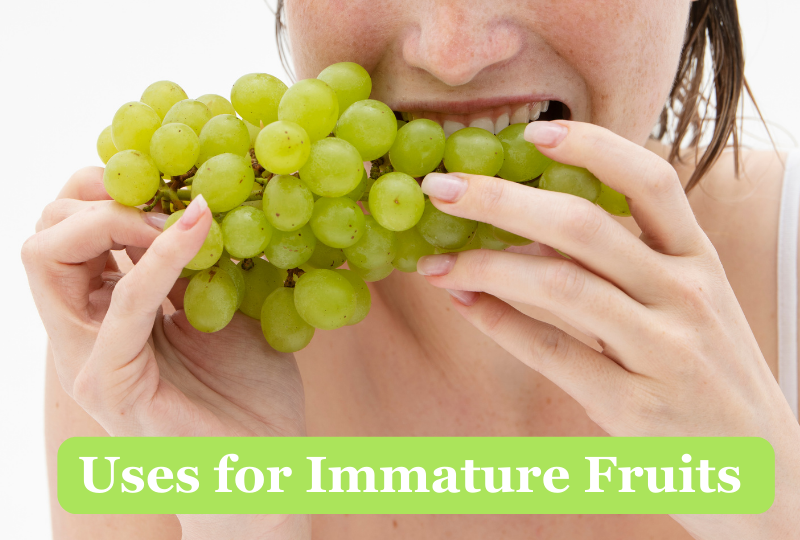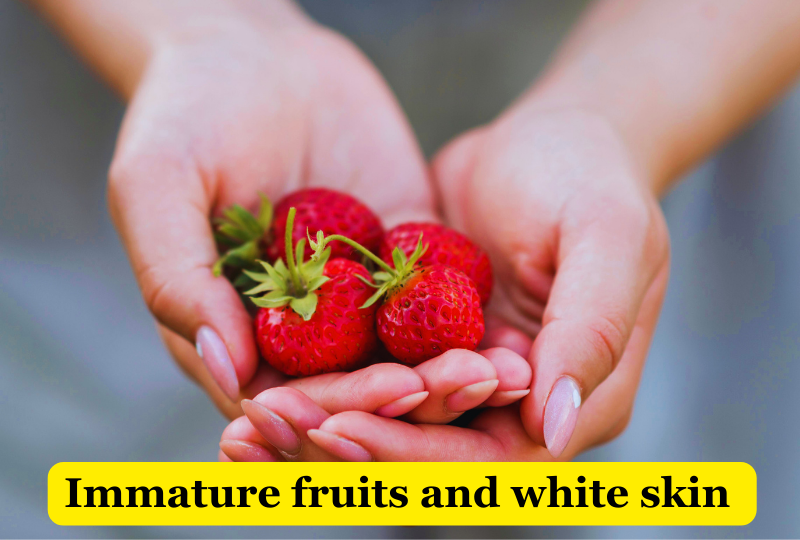Immature Fruits and White skin
When it comes to fruits, maturity and color may have a big impact on not only how they taste but also how much nutrition they contain. We’ll examine the intriguing relationship between green fruits and their effects on skin health in more detail in this post. Making informed dietary decisions requires an understanding of how consuming immature fruit might change your skin tone. Let’s examine this fascinating subject immature fruits and white skin in more detail.
What is Immature fruits?
When compared to ripe fruits of the same kind, unripe fruits typically appear hard and unripe because they have not yet reached their peak degree of ripeness.
Unripe fruit can form on plants for a variety of reasons, including temperature, humidity, nutrient deficits, or natural growth patterns. Green fruits differ from their fully ripe counterparts not just in appearance but also in flavor and texture.

Uses For Immature fruit
Green fruits can be prepared in a number of ways, including juicing, jam-making, baking, and more. It frequently takes longer to cook when used in baked items.
Since they are less sweet than completely ripe fruits, you might need to cook them for longer than you would fully ripe fruits. In addition, green fruits can be squeezed or pureed into smoothies, offering a different flavor profile from their fully ripe counterparts.
Skin Health and Immature Fruit
The role antioxidants play
Antioxidants are substances that assist in preventing oxidative stress and free radical damage to our cells. Unripe fruits are known to have higher concentrations of several antioxidants, like polyphenols and vitamin C. By scavenging dangerous free radicals that cause early aging and skin issues, these antioxidants are vital to preserving healthy skin.
Boost collagen production
A protein called collagen gives the skin structural support, helping to keep it firm and young-looking. Unripe fruits like papaya and kiwi are particularly abundant in enzymes that encourage the synthesis of collagen. These fruits’ regular ingestion might enhance skin suppleness and lessen the visibility of fine lines and wrinkles.
Earlier investigations into the white fruit’s skin tone
Genomic regions and cellular markers
Understanding the genetic makeup of unripe fruit and white skin requires the use of genomic areas and molecular markers.
Scientists can pinpoint the genes responsible for specific traits like a fruit’s color or form by using molecular markers. Genomic areas can assist pinpoint the precise location of these genes in the genome, enabling additional investigation and manipulation.
In order to cultivate and harvest immature fruits and white skin more effectively, researchers need to comprehend their genomes. Additionally, by using this knowledge, breeders might develop fresh kinds that are better suited for industrial production.

Eat immature fruit as part of your diet
When cooking, use
Fruits that are still green are not only fascinating nutritionally, but also dramatic. Green fruits are used in salads, savory meals, and seasonings in a variety of cuisines. For instance, green mango, a staple of South Asian cooking, gives a tart and cooling touch to a variety of cuisines.
A methodical approach
Although there may be advantages to eating unripe fruit, it’s crucial to maintain balance. It is unlikely that using these fruits alone will produce noticeable improvements in skin quality. Consider them as a component of a diversified, healthy diet that also contains other nutrient-dense foods.
Conclusion
White skin and green fruits have a close relationship. The W locus, a dominant gene that generates white pigment compounds in unripe fruit, is the cause of white skin. Additionally, research has revealed that the SlY2 gene plays a role in the development of the yolk in ripe fruits.
Researchers can learn more about how these features affect the process of growth and maturity by examining the locations of gene products in unripe fruit and white skin. Finally, due to their sweeter flavor and firmer texture, consumers frequently favor unripe fruits with white skin.
FAQs
Can white fruit be consumed?
Absolute! Many white fruits are edible and have unique flavors, despite tasting different from their ripe counterparts.
Are immature fruits still nutritious?
Yes, they can be a good source of vitamins and minerals and are frequently unique in their nutritional composition.
Are fruits that aren’t ripe genetically altered?
No, not always. Not all white or underripe fruit is the result of genetic manipulation, despite the fact that genetics can affect color.
Can unripe fruit serve as a substitute for cosmetics?
Unripe fruits can provide variety to your beauty regimen, but they shouldn’t be used in place of a particular skincare product.
Are there any dangers in consuming green fruit?
Most individuals can generally safely consume moderate amounts of unripe fruit. However, excessive use occasionally can cause intestinal pain.
Can unripe fruit shield you from sunburn?
Although some of the antioxidants in unripe fruit may offer minimal UV protection, sunscreen should always be worn when outdoors.
Resource Health

Pingback: organic hair care - tophealthcaretips.com
Pingback: best food for healthy eyes - Health Care
Pingback: How To Fix A Cracked Rim That Leaks Air? - Cracksin
Pingback: benefits of argan oil for hair - Health Care